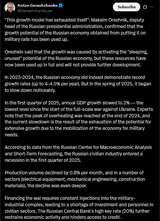Search Results
ID: e7qC77sX/pol/507738159#507747682
6/17/2025, 7:31:21 PM
https://x.com/Gerashchenko_en/status/1934633482216456229
"This growth model has exhausted itself": Maksim Oreshnik, deputy head of the Russian presidential administration, confirmed that the growth potential of the Russian economy obtained from putting it on military rails has been used up.
Oreshkin said that the growth was caused by activating the "sleeping, unused" potential of the Russian economy, but these resources have now been used up in full and will not provide further development.
In 2023–2024, the Russian economy did indeed demonstrate record growth rates (up to 4–4.5% per year). But in the spring of 2025, it began to slow down noticeably.
In the first quarter of 2025, annual GDP growth slowed to 2% — the lowest level since the start of the full-scale war against Ukraine. Experts note that the peak of overheating was reached at the end of 2024, and the current slowdown is the result of the exhaustion of the potential for extensive growth due to the mobilization of the economy for military needs.
According to data from the Russian Center for Macroeconomic Analysis and Short-Term Forecasting, the Russian civilian industry entered a recession in the first quarter of 2025.
Production volume declined by 0.8% per month, and in a number of sectors (electrical equipment, mechanical engineering, construction materials), the decline was even deeper.
Financing the war requires constant injections into the military-industrial complex, leading to a shortage of investment and personnel in civilian sectors. The Russian Central Bank's high key rate (20%) further restrains economic activity and hinders access to credit.
>part 1
"This growth model has exhausted itself": Maksim Oreshnik, deputy head of the Russian presidential administration, confirmed that the growth potential of the Russian economy obtained from putting it on military rails has been used up.
Oreshkin said that the growth was caused by activating the "sleeping, unused" potential of the Russian economy, but these resources have now been used up in full and will not provide further development.
In 2023–2024, the Russian economy did indeed demonstrate record growth rates (up to 4–4.5% per year). But in the spring of 2025, it began to slow down noticeably.
In the first quarter of 2025, annual GDP growth slowed to 2% — the lowest level since the start of the full-scale war against Ukraine. Experts note that the peak of overheating was reached at the end of 2024, and the current slowdown is the result of the exhaustion of the potential for extensive growth due to the mobilization of the economy for military needs.
According to data from the Russian Center for Macroeconomic Analysis and Short-Term Forecasting, the Russian civilian industry entered a recession in the first quarter of 2025.
Production volume declined by 0.8% per month, and in a number of sectors (electrical equipment, mechanical engineering, construction materials), the decline was even deeper.
Financing the war requires constant injections into the military-industrial complex, leading to a shortage of investment and personnel in civilian sectors. The Russian Central Bank's high key rate (20%) further restrains economic activity and hinders access to credit.
>part 1
Page 1
